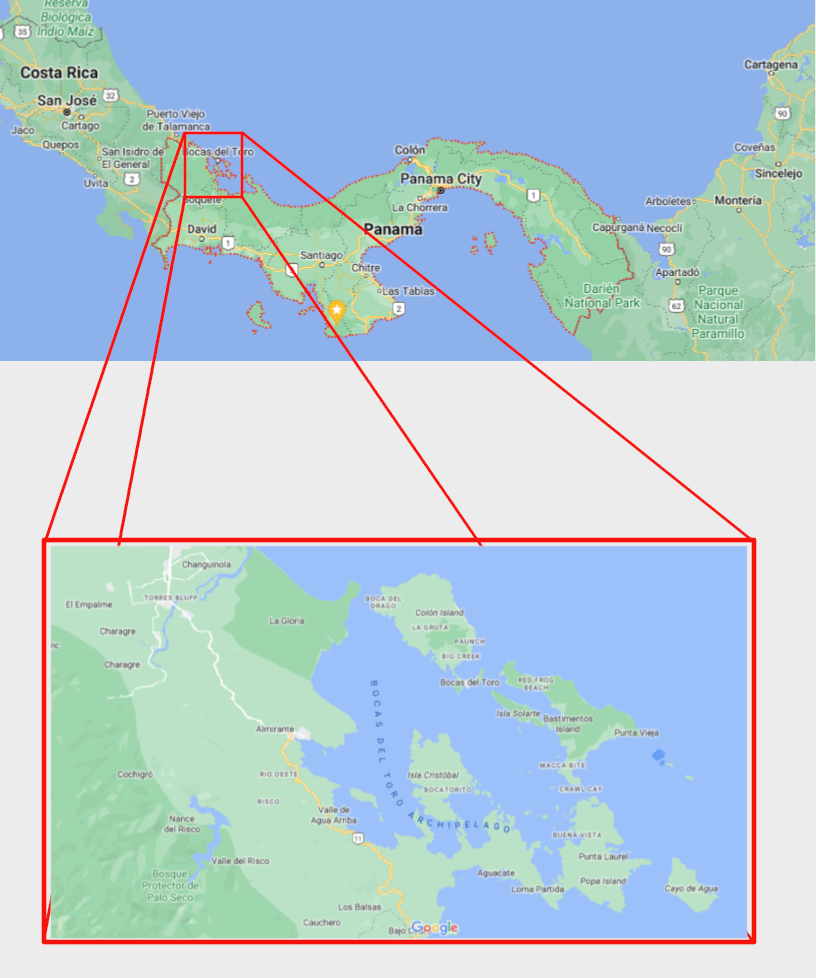Bocas del Toro is a province located in the northwestern part of Panama, along the Caribbean Sea coast. It consists of a mainland portion and a collection of islands, forming an archipelago.
Here's a geographical description of the area:
- Total Area: Bocas del Toro covers an area of approximately 4,643 square kilometers (1,791 square miles).
- Number of Islands: The province is known for its numerous islands, with estimates ranging from around 200 to over 300 islands, islets, and cays that make up the Bocas del Toro Archipelago. Some of the main islands include Isla Colón, Isla Bastimentos, Isla Carenero, and Isla Solarte.
- Inhabitants: As of my last knowledge update in September 2021, Bocas del Toro had a population of around 125,000 inhabitants. However, this number might have changed since then due to population growth.
- Main Industries: Bocas del Toro's economy is primarily based on tourism, due to its stunning beaches, clear waters, and diverse marine life. The area's natural beauty draws in visitors interested in activities such as snorkeling, scuba diving, surfing, and eco-tourism. Additionally, agriculture, particularly banana and cocoa production, has historically been important to the economy.
- Native Cultures: Bocas del Toro is home to various indigenous communities, most notably the Ngäbe-Buglé people. These indigenous groups have distinct cultures and languages, and they have maintained their traditional ways of life to some extent. The indigenous communities are often involved in sustainable practices, including crafts, agriculture, and fishing.
The provincial capital, also named Bocas del Toro, is situated on Isla Colón and serves as a hub for tourism and administrative activities. The region's unique blend of indigenous cultures, pristine landscapes, and vibrant marine ecosystems make Bocas del Toro a popular destination for both local and international travelers seeking an authentic Caribbean experience. Keep in mind that the specific details might have changed after my last update, so it's a good idea to refer to more recent sources for the most accurate information.
Bocas del Toro Ecosystems
The ecosystem of Bocas del Toro is incredibly diverse and rich, thanks to its unique geographical location, tropical climate, and combination of terrestrial and marine environments. Here's an overview of the various components of the ecosystem in the Bocas del Toro region:
- Marine Ecosystems: The Caribbean Sea surrounding the Bocas del Toro Archipelago is renowned for its biodiversity and vibrant coral reefs. The area features extensive seagrass beds, mangrove forests, and coral formations that support a wide array of marine life. These waters are home to various species of colorful fish, sea turtles, crustaceans, mollusks, and more. Snorkeling and scuba diving are popular activities for exploring this underwater wonderland.
- Mangrove Forests: The coastal areas of Bocas del Toro are lined with extensive mangrove forests. These unique ecosystems serve as crucial nurseries for many marine species, offering protection for juvenile fish and other organisms. Mangroves also help stabilize the coastline, prevent erosion, and filter nutrients from the water, contributing to the overall health of the marine ecosystem.
- Terrestrial Rainforests: The islands of Bocas del Toro are covered in lush tropical rainforests, home to an abundance of plant and animal species. These forests are characterized by towering trees, dense vegetation, and a variety of plant life, including orchids, bromeliads, and epiphytes. The rainforests are inhabited by diverse wildlife, including howler monkeys, sloths, various bird species, and amphibians.
- Freshwater Systems: Bocas del Toro has several rivers and freshwater streams that flow from the mountains into the sea. These water bodies provide important habitats for freshwater species and contribute to the overall health of the surrounding ecosystems. They also offer opportunities for activities such as kayaking and freshwater fishing.
- Indigenous Communities: The presence of indigenous communities, such as the Ngäbe-Buglé people, has had a significant influence on the ecosystem of Bocas del Toro. These communities often practice sustainable agricultural methods and have a deep understanding of the natural environment. Their traditional knowledge contributes to the preservation of local ecosystems and the maintenance of biodiversity.
- Conservation Efforts: Due to the high level of biodiversity and the importance of the ecosystem to both the local communities and the tourism industry, conservation efforts are a priority in Bocas del Toro. Initiatives include the establishment of marine protected areas, responsible tourism practices, and educational programs to raise awareness about the importance of preserving these ecosystems.
Overall, the ecosystem of Bocas del Toro is a delicate balance of marine, coastal, and terrestrial environments, showcasing the beauty and complexity of tropical ecosystems. It's important to continue efforts to protect and sustain this biodiversity-rich area for the benefit of both current and future generations.
